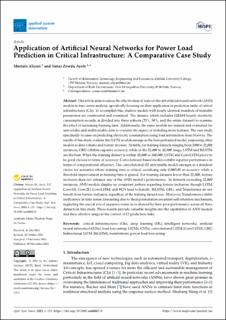| dc.description.abstract | This article aims to assess the effectiveness of state-of-the-art artificial neural network (ANN) models in time series analysis, specifically focusing on their application in prediction tasks of critical infrastructures (CIs). To accomplish this, shallow models with nearly identical numbers of trainable parameters are constructed and examined. The dataset, which includes 120,884 hourly electricity consumption records, is divided into three subsets (25%, 50%, and the entire dataset) to examine the effect of increasing training data. Additionally, the same models are trained and evaluated for univariable and multivariable data to evaluate the impact of including more features. The case study specifically focuses on predicting electricity consumption using load information from Norway. The results of this study confirm that LSTM models emerge as the best-performed model, surpassing other models as data volume and feature increase. Notably, for training datasets ranging from 2000 to 22,000 instances, GRU exhibits superior accuracy, while in the 22,000 to 42,000 range, LSTM and BiLSTM are the best. When the training dataset is within 42,000 to 360,000, LSTM and ConvLSTM prove to be good choices in terms of accuracy. Convolutional-based models exhibit superior performance in terms of computational efficiency. The convolutional 1D univariable model emerges as a standout choice for scenarios where training time is critical, sacrificing only 0.000105 in accuracy while a threefold improvement in training time is gained. For training datasets lower than 22,000, feature inclusion does not enhance any of the ANN model’s performance. In datasets exceeding 22,000 instances, ANN models display no consistent pattern regarding feature inclusion, though LSTM, Conv1D, Conv2D, ConvLSTM, and FCN tend to benefit. BiLSTM, GRU, and Transformer do not benefit from feature inclusion, regardless of the training dataset size. Moreover, Transformers exhibit inefficiency in time series forecasting due to their permutation-invariant self-attention mechanism, neglecting the crucial role of sequence order, as evidenced by their poor performance across all three datasets in this study. These results provide valuable insights into the capabilities of ANN models and their effective usage in the context of CI prediction tasks. | en_US |

